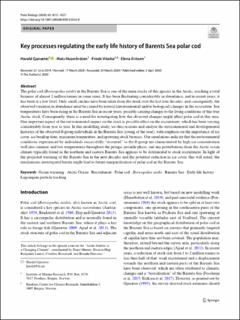| dc.description.abstract | The polar cod (Boreogadus saida) in the Barents Sea is one of the main stocks of this species in the Arctic, reaching a total biomass of almost 2 million tonnes in some years. It has been fluctuating considerably in abundance, and in recent years, it has been at a low level. Only small catches have been taken from the stock over the last four decades, and consequently, the observed variation in abundance must be caused by natural (environmental and/or biological) changes in the ecosystem. Sea temperatures have been rising in the Barents Sea in recent years, possibly causing changes to the living conditions of this true Arctic stock. Consequently, there is a need for investigating how the observed changes might affect polar cod in this area. One important aspect of the environmental impact on the stock is possible effect on the recruitment, which has been varying considerably from year to year. In this modelling study, we thus recreate and analyse the environmental and developmental histories of the observed 0-group individuals in the Barents Sea (young of the year), with emphasis on the importance of ice cover, ice breakup time, maximum temperature, and spawning stock biomass. Our simulations indicate that the environmental conditions experienced by individuals successfully “recruited” to the 0-group are characterized by high ice concentration well into summer, and low temperatures throughout the pelagic juvenile phase, and any perturbations from the Arctic ocean climate typically found in the northern and eastern Barents Sea appears to be detrimental to stock recruitment. In light of the projected warming of the Barents Sea in the next decades and the potential reduction in ice cover, this will entail, the mechanisms investigated herein might lead to future marginalization of polar cod in the Barents Sea. | en_US |
